Origami Tissue Engineering
Overview
thumb|300px|alt=Three different expansion stages of a stent show its structure.|Expansion of a stent [A]
Many bodily tissues lack the ability to self repair in the case of injury. Further there are regularly far less tissues and organs available from donors than are needed by patients. This discrepancy highlights the need to develop cost effective and viable tissue replacements.
During early development stem cells differentiate and commit to become different tissues and organs based on environmental stimuli. The fate of cells is controlled by concentration gradients, mechanical stimuli, and the relative position of cells to one another. Many strategies to make viable tissue replacements is based on mimicking the in vivo stimuli during early development. Scientists can very easily grow cells on a 2 dimensional plane, but are far less experienced at producing non homogenous 3-dimmensional cultures similar to those produced by nature. As a result researchers have pursued origami tissue engineering as a means of turning 2-dimmensional cell layers into 3-dimmensional complex structures.
The central idea behind origami tissue engineering is that a complex 3-dimmensional structure can be formed by a series of simple folding operations, as in traditional origami. By studying folding patterns and means of producing folds, the tissue engineer will gain a means of producing 3-d structures from the 2-d cultures, they are so well versed at making. For example, stents that are used for clearing up clogged blood vessels, need to start out small (to fit through small passages and catheters), and end up large. Therefore, by knowing an optimal folding pattern, the size of the initial folded stent can be reduced significantly. There are many other similar applications that use efficient fold patterns for biological and medical applications.
History
The art of Origami began in Japan around the Edo Period. Since then, people have been fascinated by the complex three dimensional structures that they could make out of a two dimensional sheet of paper. Artists began to make marvelous masterpieces causing their designs to be more and more complex. For a short amount of time in the mid 1900's, origami seemed to have reached its potential. This was until the involvement of mathematicians. These mathematicians devised intricate models for trying to explain the folding process, and derive different folding patterns. With the use of these new algorithms and models, fold patterns could be optimized to create smaller shapes or shapes with way more detail. Scientist and engineers caught on quickly to the mathematically perfect patterns and began using them for their structures and devices.
- 1603: Origami evolves as an art form in Japan
- 1900s: Origami artist begin to create more complex designs
- 1980s: Mathematicians start applying mathematical models to make even more intricate designs
- 1990: Robert Lang (Caltech) begins to study and apply these models to every day applications
- 2003: Zhong You and Kaori Kuribayashi (Oxford Univ.) develop an origami stent
- 2005: Zhong You and Kaori Kuribayashi innovate their stent so that it is self deployable
Applications
Stents
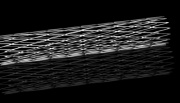
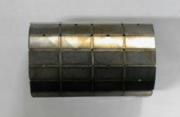
Kaori Kuribayashi and Zhong You from the university of Oxford, UK have created stentgrafts made out of a Ni-rich titanium/nickel foil that utilizes origami folding. Traditional wire stents often result in restenosis due to their porous/mesh nature[4]. Restenosis occurs when tissues grow through the pores of the emsh and create blockages[5]. Because the stent graft is made of TiNi foil with no holes, no tissue in-growth can occur. In addition the stent grafts deploy as a result of a change in temperature. The transition temperature can be controlled by altering the amount of nickel used in the foil. Once the stent reaches the desired destination in the artery or vein, it is pushed out of the catheter where it will expand to its full size without the use of a traditional balloon. The automatic deployment works by two different mechanisms: one is triggered by heat (of the body for example) while the other is triggered solely due to the super elastic behavior of the material[1].
Material Qualities & Preparation
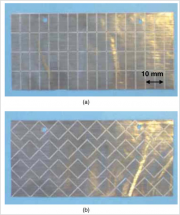
This Ni-rich Ti/Ni foil falls under a class of materials called a shape-memory alloy(SMA) which means that the material always wants to return to the shape at which it was cold forged. Having a material be a SMA is ideal for origami engineering since it will want to spring back to its original shape after being folded. Another wonderful property of this material is that it is biocompatable with the body and will induce no negative immune response[6]. The reason why such materials were not used before, is because it was very challenging and expensive to make a TiNi foil (or another biocompatable SMA) so thin while retaining its properties. Now due to research from the early 2000's, it is possible to create such a material relatively inexpensively[1].
To tailor program the cylindrical shape memory Kuribayashi and You aged the material at 773k for 20-40h[1]. Next a folding pattern is devised and creases are applied to the foil by using a negative photo-chemical etching process[1]. Following the rules of origami, different patterns were made on either side side of the foil. Once the foil was etched, all that needed to be done to fold the stent was to sub cool it using liquid nitrogen. Folding occurs because the foil contracts at cold temperatures, and the foil buckles at points where there is less stress. Points of less stress for these stents are the etched lines.
Results
In a simple experiment where a tube the diameter of a catheter was used to implant the stent into a second tube the diameter of an artery, the stent expanded quickly and effectively. In fact the speed of the unfolding was so fast that a high speed camera was needed to capture the motion. The tube that was meant to mimic the artery must reach 319 K before the stent would deploy[1]. Unfortunately this is above body tempeature, but may be altered by changes the relative amount of Nickel and Titanium
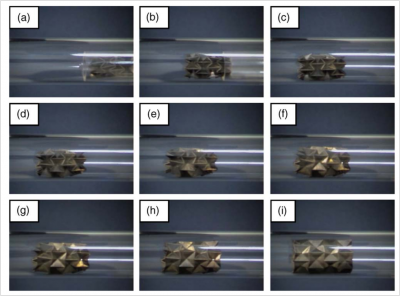
Origami Alveoli
Origami alveoli are a model to study the way alveoli work. The reason for using an origami model is that the shape of alveoli changes with time. This requires a model that also can change shape with time, which is also known as a 4D model. First a mathematical model was created that mimicked the motions of each moving part in the alveoli. Next an origami model was built of the duct and the alveoli to be able to visually see the impacts of different conditions.[7]
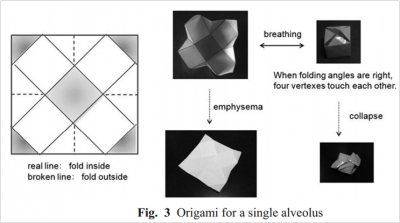
Cell Origami
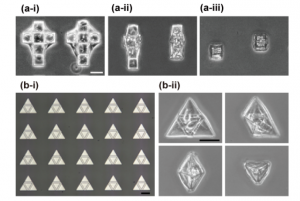
Scientists from the University of Tokyo, Japan designed an experiment that created a self folding cell-laden micro-structure. They named this new method, "Self-Folding Cell Origami". The premise was to use a force that cells exerted naturally, the cell traction force (CTF), in order to make a controlled three dimensional structure. In their experiments, the researchers coated glass plates with a gel that cells could not attach to. They then placed micro plates on the plate a short distance apart. Cells were then seeded on the micro plates. The cells then bridged the gap and pulled against each other, creating a 3-d structure.
Further studies showed that the fold angle directly correlated to the number of cell attachments spanning the gap between micro plates. Researchers were able to create a box, a tube, and a dodecahedron structure, by altering the micro plate pattern and by change the number of cells seeded[2]. These preliminary results provide a strong basis for further research into producing 3-d structure from 2-d cell sheets.
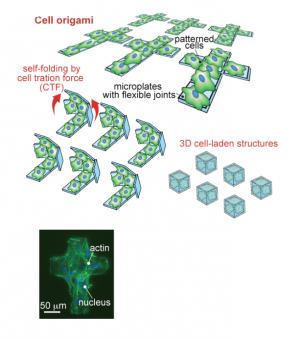
DNA origami refers to the self assembly of hundreds of oligonucleotide into well defined 3-dimmensional structures. Shawn Douglas has used this technique o create a nano robot using DNA origami. A 35 nm X 35 nm x 45 nm barrel was produced by annealing a 7308 base pair template strand with 196 oligonucleotide base strands. The robot was designed using cadnano, a computer aided design program specifically for DNA origami. The robot is capable of selectively interacting with cells by sensing antigens and releasing a payload as a result. The barrel is held shut by a DNA locking mechanism made of two semi-complementary DNA strands. When the antigen comes enar this domain, the semi-complementary sequence will release form the sequence complimentary to the antigen and the barrel springs open delivering its payload. This DNA origami nano robot has obvious applications for drug delivery and cell culture experiments.
References
- K. Kuribayashi et al. Self-deployable origami stent grafts as a biomedical applicationof Ni-rich TiNi shape memory alloy foi. Materials Science and Engineering 2006, A 419, 131-137.
- K. Kuribayashi-Shigetomi, H. Onoe and S. Takeuch SELF-FOLDING CELL ORIGAMI: BATCH PROCESS OF SELF-FOLDING 3D CELL-LADEN MICROSTRUCTURES ACTUATED BY CELL TRACTION FORCE. MEMS 2012, 72.
- Tae Soup Shim, Shin-Hyun Kim, Chul-Joon Heo, Hwan Chul Jeon, and Seung-Man Yang Controlled Origami Folding of Hydrogel Bilayers with Sustained Reversibility for Robust Microcarrier. Angew. Che 2012, 124, 1449-1452.
- E.R. Edelman, C. Rogers, Circulation 94 (1996) 1199–1202.
- M. Gottsauner-Wolf, D.J. Moliterno, A.M. Lincoff, E.J. Topol, Clin. Cardiol. 19 (1996) 347–356.
- J. Ryhanen, Biocompatibility evaluation of nickel–titanium shape memory metal alloy, in: Dissertation, University Hospital of Oulu, Oulu,1999
- H. Kitaoka et al. Origami Model for Breathing Alveol, Advances in Experimental Medicine and Biology, 669, 2010 49-52
IMAGES
[A] <http://www.sciencemag.org.silk.library.umass.edu/content/332/6036/1376/F2.expansion.html>
[B] <http://news.injuryboard.com/johnson-amp-johnson-wins-patent-case-on-heart-stents.aspx?googleid=28948>
[C] K. Kuribayashi et al. Self-deployable origami stent grafts as a biomedical applicationof Ni-rich TiNi shape memory alloy foi. Materials Science and Engineering 2006, A 419, 131-137.
[D] K. Kuribayashi et al. Self-deployable origami stent grafts as a biomedical applicationof Ni-rich TiNi shape memory alloy foi. Materials Science and Engineering 2006, A 419, 131-137.
[E] K. Kuribayashi et al. Self-deployable origami stent grafts as a biomedical applicationof Ni-rich TiNi shape memory alloy foi. Materials Science and Engineering 2006, A 419, 131-137.
[F] H. Kitaoka et al. Origami Model for Breathing Alveol, Advances in Experimental Medicine and Biology, 669, 2010 49-52
[G]-[H] K. Kuribayashi-Shigetomi, H. Onoe and S. Takeuch SELF-FOLDING CELL ORIGAMI: BATCH PROCESS OF SELF-FOLDING 3D CELL-LADEN MICROSTRUCTURES ACTUATED BY CELL TRACTION FORCE. MEMS 2012, 72.
[I]Tae Soup Shim, Shin-Hyun Kim, Chul-Joon Heo, Hwan Chul Jeon, and Seung-Man Yang Controlled Origami Folding of Hydrogel Bilayers with Sustained Reversibility for Robust Microcarrier. Angew. Che 2012, 124, 1449-1452.

